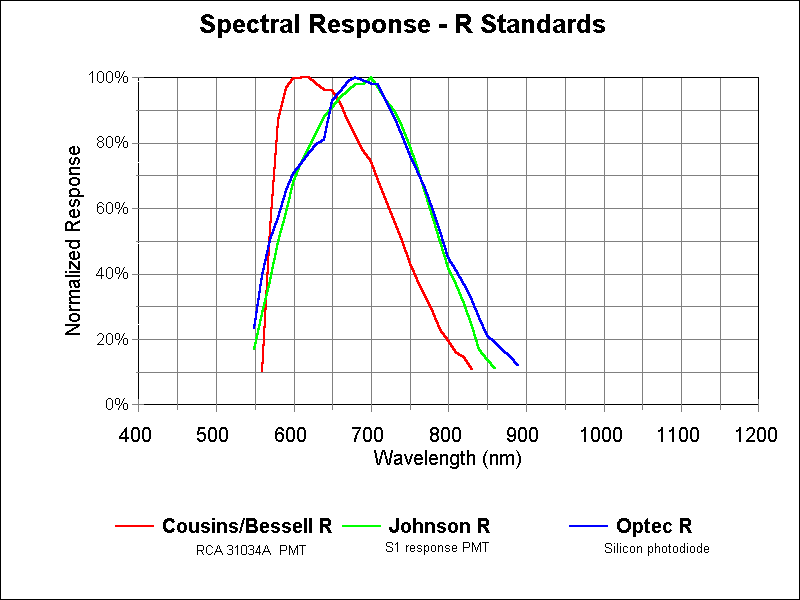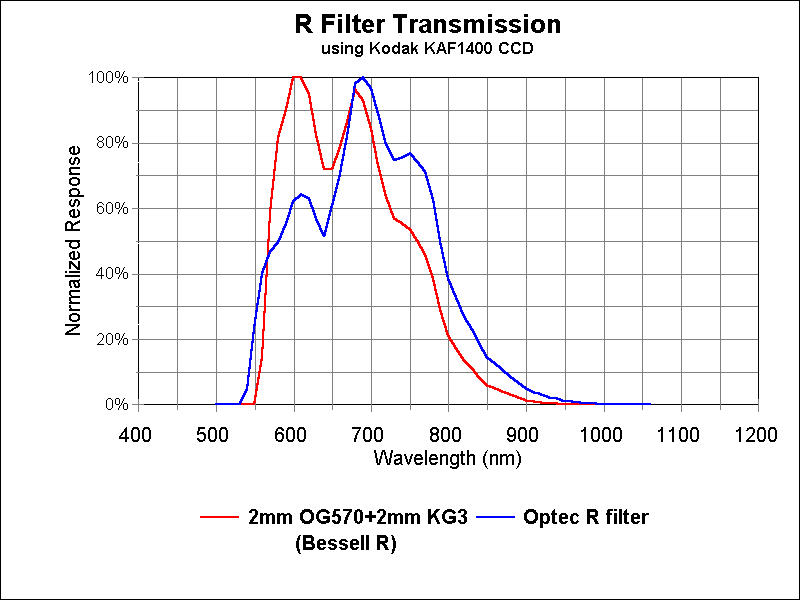Optec Distribution
![]() News
News ![]() Notes & Literature
Notes & Literature ![]() Overview
Overview ![]() Pricing
Pricing ![]() Products
Products
Temperature Compensating Focuser
![]() Color Filter Wheel
Color Filter Wheel
![]() Filters
Filters
![]() Lenses, Optics
Lenses, Optics

Cousins/Bessell vs. Johnson Filter Standards
by Gerald PershaPresident, Optec, Inc.
![]() Also available in Adobe PDF Format (768,694 Bytes>
Also available in Adobe PDF Format (768,694 Bytes>
Identifying broad band "standard" photometric filters for photometry with CCDs is causing some confusion among users. While the filter systems of Johnson and Cousins/Bessell are described in numerous articles and the pros and cons of each battered about, I don't think users really have a good handle on what system to use. The statement "accepted by the professional community" doesn't really help one make a decision since the results of either system used properly are acceptable. I will attempt in this brief monograph to shed some light on choosing the "right" system.
First off, by their very nature the broad band filters of either system are ill defined and the inherent scatter in the data is a natural result. Rather than being defined wholly by the filter, these systems depend on the detector to a large degree to define the shape and width of the pass band. For example, the original Johnson V used the red fall off of the 1P21 tube to define the long wavelength side of the pass band. Now with CCDs, photodiodes, extended red PMTs and other detectors with red response, the V pass band must now depend on colored glass to emulate this red fall off. Normally, BG18 glass from Schott is used, but other glasses from Schott or other glass companies have also been used. Obviously, these new detectors all have a different red fall-off and, since no two glasses have the same transmission unless they come from the same melt, the red fall off for everyone's V is unequal. This also applies to the I filter of each system. The Johnson I depends on the red fall off of a PMT with S-1 (later with S-20) response and the Cousins/Bessell I depends on the red fall off of the RCA 31034-A (now Burle 31034-A) tube. At 870 nm the cathode response of the RCA 31034-A can vary by more than 10 to 1 with a 100 degree C temperature change. Since the cathode response at 650 nm is nearly unchanged with the same temperature variation, the resulting red fall off of the Cousins/Bessell I is very temperature dependent. You would think people would wise up in 30 years.
The atmosphere plays a big roll in defining the shape of the pass band for the U, R and I filters of each system. The U filter is supposed to pass wavelengths as short as 300 nm to the detector, but this is only obtainable in space. Since the amount of UV radiation around this wavelength depends greatly on air mass, air quality and the total thickness of normal glass used in one's telescope and photometer, a precise U magnitude is difficult to obtain in the real world. That is why one must contend with the K" fudge factor in the data reduction when using this filter. Similarly, the extensive molecular scattering in the atmosphere primarily from water vapor at wavelengths in the range from 600 nm to 1100 nm causes serious scatter in the data for the R and I band of either system. Unless one is observing in space again, not much can be done about this problem. For example: on a good night with visibility greater than 50 miles, the transmission at 760 nm (a major O2 absorption band) can vary from 65% at 1 air mass to 45% for 2 air masses. Slightly off the absorption band at 750 nm the transmission changes from 89% to 82% for the same two air masses. For the Cousins/Bessell I filter there is a serious H2O absorption which would affect the red fall off and the degree of this fall off would be dependent on the dryness of the air during the observation.
The transmission variability of colored glass from one melt to another can also be very troublesome. While temperature glasses such as the GG and OG type can be very exact, the BG, KG and RG type can be all over the place from melt to melt. The art of making colored glasses is still an art with many formulas for glass brews still held secret in the smoky bowels of Schott, Hoya and Corning. To control the transmission through these glasses it is necessary to get melt data for a certain thickness and then tailor the thickness of the filter to match the desired pass band.
The prescription that I have seen for most Cousins/Bessell R filters is 3 mm OG570 and 2 mm of KG3 glass. The environmental stability of the KG3 glass is rated a 4 by Schott which, from the Schott data book' states "poor resistance; prone to weathering and therefore special protection during use may be necessary." This glass will pit and will look frosted after a few years exposure to our not so clean air. Thus, this glass should be sandwiched between the OG glass and another glass such as BK7 or similar to be protected. Most of the other glasses used in the construction of these filters are also prone to weathering but to a lesser degree.
Comparing the Cousins/Bessell to Johnson filters on a practical basis there isn't much difference. The U, B and V filter pass bands are the same and the only real differences are in the R and I bands. In the case of the I band the only difference is that the red fall off of the Cousins/Bessell I is at 900 nm due to the RCA 31034-A and at 1000 nm for the Johnson I due to the S-1 response. The short wavelength cut-on at 700 nm is the same for both filters. The Optec I filter has a cut on closer to 750 nm which was implemented after it became clear from users that, to minimize the transformation coefficient epsilon for (V-I), the pass band needed to be pushed more to the red. One can only speculate that the published detector/filter response function from Johnson was slightly off - perhaps his RG type glass was redder than expected.
A Johnson I filter can be magically transformed to a Cousins/Bessell I by using a detector with similar response to the RCA tube or by having an expensive dielectric "short pass" coating with a cut off at 870 nm applied to the filter. Nearly all commercial Cousins/Bessell I filters I have seen advertised do not have this coating. How they can be called a Cousins/Bessell I when used with a CCD camera escapes me. I won't even get into the optical problems of these type of coatings.
The Cousins/Bessell and Johnson R filters are different but not by very much. The Cousins/Bessell R passes a little more on the blue side compared to the Johnson R. The important thing to consider is that either system is transformable to the other. That is having V and R Johnson magnitudes one can compute a Cousins/Bessell R and the opposite is true as well. This cross relationship also apples to the I filter. Considering all the other sources of error in a wide band system, the inaccuracies due to the transformation process are minor indeed.
Whether one chooses a Cousins/Bessell or Johnson system is not really the central issue. It is more important to establish what the principal astronomer or the variable star organization you are working with requires for a photometric system. Purchasing either a well designed and manufactured set of Johnson or Cousins/Bessell filters, in my opinion, would be equally a good choice. It is well know that most professional observatories with large telescopes and super expensive CCD cameras use Cousins/Bessell filters, but to compare one's own 10 inch SCT with a ST-6 camera to that for the purpose of selecting filters would be a little presumptuous on ones part. The great body of photometric data over the last 50 years from both amateur and professional telescopes has been made mostly with the Johnson system for better or worst.
Optec has sold hundreds of Johnson UBVRI filter sets over the last 20 years. These filter sets have been used successfully in both amateur and professional observatories through out the world. Our original Johnson set was first used with Optec's SSP-1, SSP-2 and SSP-3 silicon photodiode photometer. Later, a similar Johnson set comprising UBVR was designed in 1989 to be used with our SSP-5 photometer using a multialkali PMT.
In conclusion, I would like to restate that, scientifically, both systems are equally acceptable for wide band photometry. Again, scientifically, both systems are flawed for the reasons stated above. The design and quality and implementation of the filters selected should be of top concern for the user regardless of the system chosen.

Above Illustration: Spectral Response - R Standard (145,039 bytes)

Above Illustration: Spectral Response - I Standard (141,865 bytes)>
The graphs titled "Spectral Response - R Standards" and "Spectral Response - I Standards" were prepared using original source material. The Johnson curves are from the Johnson, H. L., 1965, Astrophysical Journal, Vol. 141, 923. The Bessell curves were computed from filter transmission and cathode response data from Appendix 1 of Bessell, M.S., 1979, PASP, Vol. 91, p 589. The Optec curve was generated from measurements made in-house with a grating monochromator having a 1 nm bandpass and a calibrated (NBS traceable) silicon photodiode. The normalized response is the product of filter transmission and detector response in A/W. The result is then normalized for comparison purposes. These standards are what users wish to match with their photometric equipment. The Optec "standard", which strives to match Johnson, is more or less a de facto standard because it has been widely distributed through out the world for many years for better or worst.

Above Illustration: Spectral Response using Kodak KAF1400 CCD - R Filter Transmission (144,673 bytes)

Above Illustration: Spectral Response using Kodak KAF1400 CCD - I Filter Transmission (143,693 bytes)
The graphs titled "R Filter Transmission" and "I Filter Transmission" compare the Optec R and I filters (latest transmission data) and the Bessell filter formulae as detailed in Bessell, M. S., 1995, CCD Astronomy, Fall, 20, when used with a popular CCD chip the KAF1400. The KAF1400 spectral response was taken from factory data sheets. As one can see comparing response data for real filters and a real CCD, a new and unique "standard" response curve for R and I is now upon us.
What does this all mean? Not much. This is just the way things are in wide band photometry.
P.S. Twenty years ago Johnson and Mitchell established a medium-narrow 13 color photometric system which solves many of the problems previously discussed. They even complied a list of 1380 standard stars. I remember supplying a subset of this system to a SSP customer many years ago but have no idea how it fared. Speaking as an instrument maker, this set would be ideal for CCD use.
Contents Copyright 1994-2003 Company Seven All Rights Reserved

